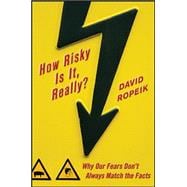
Note: Supplemental materials are not guaranteed with Rental or Used book purchases.
Purchase Benefits
What is included with this book?
| Acknowledgments | p. ix |
| Introduction | p. xi |
| This is your Brain on Fear | p. 1 |
| The Amygdala to the Rescue: Hard-Wired to Fear First and Think Second | p. 2 |
| The Fear Response Continues | p. 7 |
| Built-in Fears | p. 14 |
| Bounded Rationality: Because reason alone can't keep you safe | p. 21 |
| Mental Shortcuts for Making Decisions | p. 23 |
| The Framing Effect | p. 26 |
| Categorization: The Representativeness Effect | p. 32 |
| Loss Aversion | p. 40 |
| Anchoring and Adjustment | p. 45 |
| The Awareness/Ready Recall Effect | p. 48 |
| Innumeracy | p. 52 |
| Optimism Bias | p. 56 |
| Fear factors: Why some threats feel scarier than Others | p. 65 |
| Principles behind Risk Perception Factors | p. 68 |
| Trust | p. 70 |
| Risk versus Benefit | p. 81 |
| Control | p. 85 |
| Choice | p. 89 |
| Is the Risk Natural or Human-Made? | p. 92 |
| Pain and Suffering | p. 96 |
| Uncertainty | p. 99 |
| Catastrophic or Chronic | p. 105 |
| Can It Happen to Me? | p. 109 |
| Is the Risk New or Familiar? | p. 114 |
| Risks to Children | p. 119 |
| Personification | p. 126 |
| Fairness | p. 130 |
| Risk Perception Factors Redux | p. 132 |
| The wisdom or the madness of the crowd? | p. 135 |
| A Conversation about Climate Change | p. 135 |
| Cultural Cognition | p. 142 |
| Chicken Little, Pollyanna, and Other Social Forces | p. 156 |
| And That's the Way It Is | p. 166 |
| Closing the Perception gap | p. 187 |
| The Risk of Getting Risk "Wrong" as individuals | p. 187 |
| The Risk of Getting Risk "Wrong" as a Society | p. 198 |
| Toward Healthier Individual Choices | p. 214 |
| Toward Healthier Choices as a Society | p. 237 |
| Closing Thoughts | p. 259 |
| Endnotes | p. 263 |
| Index | p. 271 |
| Table of Contents provided by Ingram. All Rights Reserved. |
The New copy of this book will include any supplemental materials advertised. Please check the title of the book to determine if it should include any access cards, study guides, lab manuals, CDs, etc.
The Used, Rental and eBook copies of this book are not guaranteed to include any supplemental materials. Typically, only the book itself is included. This is true even if the title states it includes any access cards, study guides, lab manuals, CDs, etc.